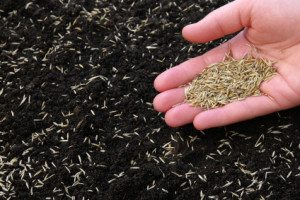It’s hard to believe that October is almost halfway over, and that means time is running out to aerate and overseed your fescue lawn. If you have a fescue lawn, you may have noticed thinning over the summer. You may also see dead patches of grass caused by disease due to all the rain we got this summer. If your lawn is suffering from any of these conditions, now is the time to fix it! Fall is the best time to seed fescue lawns, seeding now will make your lawn more disease and drought tolerant next summer.
Seed germinates best when temperatures are between 60 and 70 degrees, and it can take 2-3 weeks for full germination so time is running out to get your seed down. If you are a do it yourselfer, look for seed with multiple cultivars of fescue seed (3 types is most common). Also, make sure you put down a good starter fertilizer along with the seed.
Before seeding, it’s a good idea to aerate your lawn. Core aeration removes hundreds of small (2 to 3 inch) soil cores from the soil. After aerating your lawn, it will be filled with small holes (which is a good thing). Aeration has many benefits for your lawn; it reduces soil compaction and increases water absorption. Seed also collects into the aeration holes, which reduces drift from wind and water. Make sure to water the lawn the night before you aerate, having moist soil will result in deeper cores.
If you need any help with aeration and seeding of your fescue lawn, we are here to help. We offer full aeration and seeding services, and would be happy to provide you with a free estimate. To get an estimate or schedule service, give us a call at (919) 999-0936.
Happy Seeding!
Tyler




